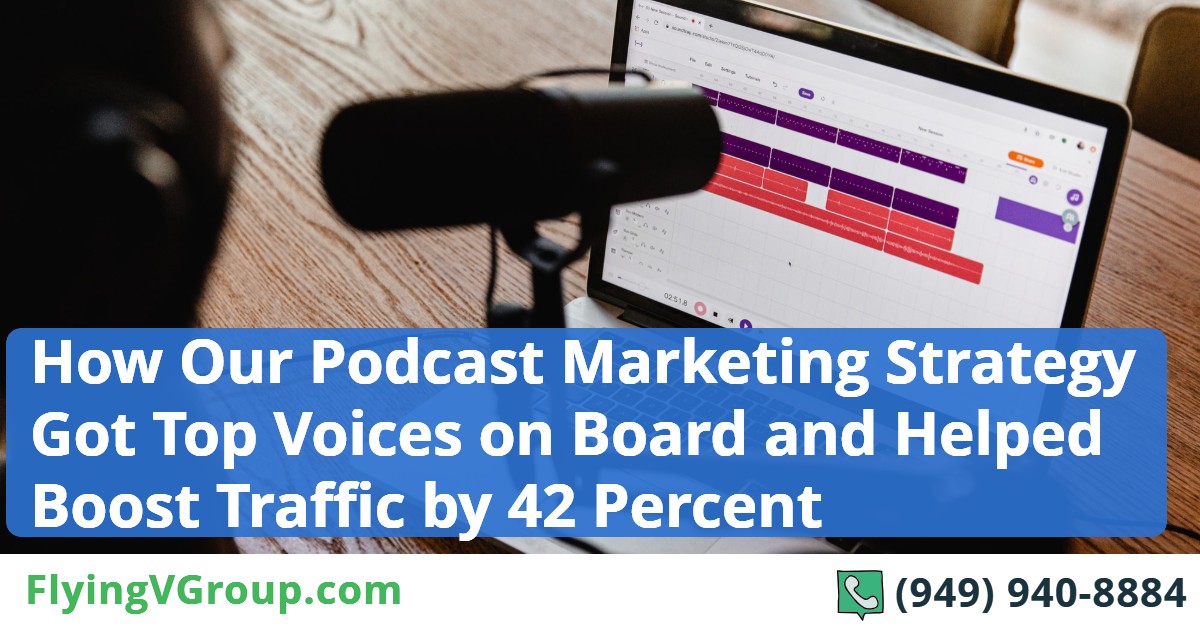Podcast marketing is hardly a recent fad: it’s been around in some shape or form for almost 20 years. However, the recent growth in podcast popularity – thanks in large part to Spotify and Apple Podcasts – makes this an exciting and very promising digital marketing channel to explore.
Podcast marketing is playing a bigger role: small business owners, influencers, and consultants, are all embracing the podcast format because it provides a quicker and more cost-effective way to reach audiences.
At Flying V Group, we’ve been on our own podcasting journey: the Sage Executive Podcast has hosted over 22 speakers across roles and industries. The Sage podcast has been a significant driver of growth and conversions: We have had 42% increase in website traffic and an increase of time on site from one minute 25 seconds to two minutes and 15 seconds thanks to the podcast.
We’ve had our own podcast success story, and in this post, we’ll:
- Lay out the reasons why you should start a podcast
- Help you get to grips with podcast challenges
- Offer actionable insights to hit the ground running
- Explain how to turn a good podcast into a great lead generator
Why Podcast marketing?
Podcasting is a medium on the rise. Studies show that 51% of Americans over the age of 12 have listened to a podcast. 32% of them tune in at least once a month. There are some generational differences in podcast adoption rates. However, this seems to be working in favor of overall growth: Podcasts currently make up 10% of all content that millennials consume.
These numbers highlight just how big the medium is. So far however, many creators continue to treat podcasts like any other medium, focusing on ad-supported monetization.
It’s time for that to change. More and more marketers are creating podcasts that talk about specific business functions, from digital marketing to finance to HR to learning and more. They target highly-engaged niche audiences, offering tangible value and driving lead generation. This is something we’ve seen with Sage: the value of the qualified, inbound leads we get from a great episode, is several thousand times greater than potential ad revenue.
Building a great podcast and turning into a lead magnet can have a tangible impact on your bottom line: we’ve closed deals with clients who reached out just because they heard a Sage episode that resonated with them.
A regular podcast channel can be a great asset, but how do you get started? Let’s take a look at some of the initial challenges.
The initial challenges
Getting a podcast up and running is…complicated, to say the least. Beyond just the cost and technical requirements, there were a range of issues we had to address. Let’s look at some of the issues we faced:
What’s the right format? How long should each episode be? How many speakers should we have on at a time and kind of content should we focus on? We spent a lot of time thinking these points through individually, but it just didn’t click.
Then, we thought about working backwards: we set key overall goals: to boost traffic and to generate conversions. Then, we went back to those questions and things became clearer.
The lesson here is simple: you need to have a clear understanding of your “why,” a mission statement of sorts for your podcast. This’ll function as a frame of reference both for technical questions and issues of style and approach way.
There’s one more question you need to answer: “What’s in it for them?” What incentivizes your audience to listen to and engage with your podcast? What tangible value are you offering?
Cost and effort
Those first few episodes can be tough in terms of cost and effort: You’ll need to get the right technical infrastructure in place, find qualified speakers, and market your podcast: there are so many factors to consider.
Define a clear SOP and follow through on it. Make sure everyone on the team is onboard with the idea of a podcast and that they’re putting in the right effort. And have a can-do, learning attitude: These are the things we focused on. Those first steps are the hardest, but once you have a clear process in place, it all comes together.
Getting the right names on your podcast
There are many ways to approach the format of your podcast. You can have interview-style podcasts, do group discussions, or just could have two subject matter experts conversing.
But before all that, here’s a question you’ll almost certainly face: who are the right people to have on your podcast? Do you go with a “famous” person or do you opt for someone who’s relevant to your niche? There is no definite answer, but the “mission statement” we spoke about maybe of help here.
Currently, we have industry leaders like Y and Z on the Saege podcast but this wasn’t the case before. We started by reaching out to less well-known guests, but who were subject matter experts in their domains. For example, if we were going to talk about PPC campaigns for small businesses, it would be a better option to go with a small business owner to talk about how she/he runs his campaigns and the results it has had.
Even today, we make sure to work regularly with these kind of guests.
Giving your audience actionable information is an important part of your podcast strategy. When you prefer smaller, more “relevant” guests over “famous” guests, you’ll end up with more control over the narrative, you’ll be able to establish a clear identity that your guest won’t overshadow, and you’ll almost certainly get more actionable insights your readers can put to use.
What are the right marketing channels?
Market your podcasts just like you would any other valuable content asset. We found that using existing social channels like Twitter, LinkedIn, and Facebook were the best way to reach out and grow an audience. Beyond social media, podcasts can also be a part of your monthly newsletters, banner ads on your site, and any other channel you are present on.
It’s not just where you promote your podcast that’s important: what you promote matters too. Consider posting excerpts from the podcast to draw the audience’s attention: share small teasers with the most interesting parts of your episode. If you have speakers, make sure to tag them in the posts. They can then share with their network, expanding your listener pool.
How we turned our podcast into a lead generator
When we started out, we had a clear long-term goal for the Sage Executive Podcast: we wanted to turn it into a serious lead generation channel. Having a clear idea of what we wanted to do helped us in being more focused and effective with our podcast. Let’s take a look at a few more actionable tips.
Build out an SOP
Have a clear SOP in place for your podcast. This includes having a clear wireframe for each episode too. Your SOO allows you to set expectations clearly, so listeners clearly know what to expect and when. This also allows them to skip the parts they are less invested in and to focus on the most engaging sections.
Having an SOP is also particularly helpful in keeping the conversation on track, making sure you’re getting to the point without wasting listener time.
Talk about real challenges and actions
If there is one thing that you take away from this blog, let it be this: Make sure that you are talking about real problems you/your client/your speaker faced and the steps that she/he took to overcome them. There is nothing worse than pontificating on your podcast episode. The best value you give to your listeners would be for them to walk away with actionable insights that they can apply to their problems.
Get into numbers
Do not shy away from numbers. When you are sharing use cases and actionable insights, numbers add credibility and authority. Talk about how a specific action helped your speaker or the business in question grow. You can talk about sales numbers, lead numbers, savings – anything that shows the impact that the action has had.
Add natural CTAs in multiple locations
You need to be strategic about adding CTAs. Rather than keeping them at the very end or beginning, it’s a better idea to embed multiple natural CTAs in different locations. One good location is right after the speaker introductions.
Use different kinds of CTAs that encourage different actions: they could direct listeners to download an asset, sign up for a demo, or to sign up for your newsletter list. Remember to make your CTAs contextual: For instance, If the speaker shares an actionable insight, you can guide the audience to an e-book or a mailing list if they want notes or additional input.
Conclusion
Podcasts are a great channel to share your content, grow an audience, and generate leads.
But like any marketing channel, your podcast will require planning and consistency. Initial setup can be tough, but once you have things in place, it becomes easier for subsequent iterations. Remember to set your expectations: Your podcast is unlikely to pick up thousands of listeners with just a couple episodes. You need to keep creating great content and find interesting ways to market your podcast too to the right audiences . Remember, though, a smaller, focused, high intent audience will always convert better than a larger audience of general listeners.
By focusing on the right audiences, delivering value, and working with guests who offered actionable insights, we were able to grow Sage’s viewership by 84% percent over just one year.
If you’re looking to grow your podcast presence, reach out to us and let’s get the ball rolling!
SHARE THIS POST
Thank you so much for reading How Our Podcast Marketing Strategy Got Top Voices on Board and Helped Boost Traffic by 42 Percent. We really appreciate it! If you have any questions about our article, or can suggest any other topics you think we should explore, feel free to let us know.
Be sure to sign-up for our newsletter to receive monthly emails on all of the latest trends and happenings in the digital marketing space. You will also receive our FREE E-Book with the Amazing Marketing Tools for Powerful Business Growth. Sign-up below!
Also, if you received some value out of this article, please share with your friends or colleagues, or leave a comment/question below. We really appreciate you reading our blog and every share/comment means the world to us and allows us to continue producing valuable tools to help you grow your business!





0 Comments